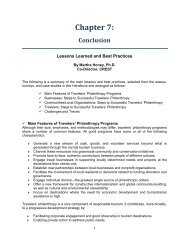Chapter 2: - Center for Responsible Travel
Chapter 2: - Center for Responsible Travel
Chapter 2: - Center for Responsible Travel
You also want an ePaper? Increase the reach of your titles
YUMPU automatically turns print PDFs into web optimized ePapers that Google loves.
we brought tourism to these communities we could bring economic opportunity, create businesslinkages, and help augment the income of poor households.At this stage, we had no idea what travelers‘ philanthropy was, that it was possible, or even thatthe concept existed.The Shift Towards <strong>Travel</strong>ers’ PhilanthropyAs we took visitors into the township areas on our tours, a <strong>for</strong>ce was unleashed which we hadnever anticipated. More and more tourists asked about supporting the projects we visited, suchas schools, craft initiatives, and health facilities. It dawned on us this was an opportunity todirect resources towards these projects. In 1999, a recent immigrant from Scotland, MarionGate, took a couple of tours with us and then approached us about setting up a legal entity <strong>for</strong>fundraising to support township projects. This was how Calabash Trust was started. In 2000, itwas registered as a not –<strong>for</strong>-profit entity, and was granted legal status. Calabash Trust is aseparate legal entity from the tour company, with its own board of trustees. So we embarked onthe travelers‘ philanthropy path, at the request of our clients!I don‘t think any of us involved in the beginning had any idea what we were doing, where itwould lead, and that we would eventually identify our work as part of the travelers‘ philanthropymovement.The EvolutionInitially, all we did was tell our tour participants aboutthe Trust, so any pens, pencils, money, goods, etcthey wanted to contribute could be managed, andaccounted <strong>for</strong>. We soon determined that if we weregiving projects money, we needed to be sure theycould account <strong>for</strong> it. Sometimes they lacked capacityto do so. Soon we were delivering small, in<strong>for</strong>malworkshops on book keeping, or minute keeping, andgeneral administration. Donations were slow in thebeginning, and my co-founder Marion was alsoinvolving friends and family in Scotland to generatesmall donations.Home visit on township tour, South Africa.Credit: Calabash ToursSome Early ChallengesooooHow were we going to prevent a dependency situation being created in the projects wewere supporting?How were we going to channel small amounts of money from around the world into ourSouth African bank account, without it being eaten by international bank charges?How were we going to monitor the progress of the projects?How would we identify projects?39















